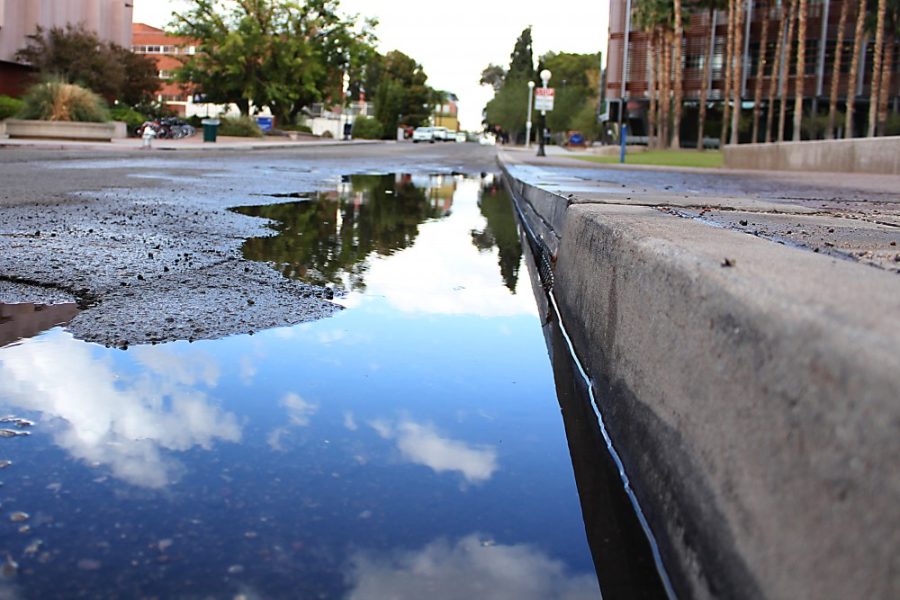The buildup of water in the streets following Monday’s rain proved to be bothersome to bicyclists and pedestrians, and while it’s not a big deal to UA Facilities Management, students have mixed feelings.
The morning rain left large puddles in the streets on campus throughout most of the day, especially on Park Avenue and the UA Mall. The buildup caused many students, especially those riding bicycles and walking, to either ride or walk through the water, travel a different route or even use a different means of transportation altogether. But despite the setbacks, UA Facilities Management said Monday’s rain really wasn’t a problem.
“The water we had today (Monday), to be honest, was nothing,” said Chris Kopach, director of Facilities Management. “It was a very slow rain. When we get these rains where we get an inch every half-hour, that’s where we have some trouble.”
But Facilities Management, as well as the City of Tucson, has worked closely to minimize the problems that come with heavy rains and the water they leave behind. Kopach said that they have made and are continuing to make efforts to detain the water.
“We’ve been able to do several harvesting projects channeling water to Bear Down Field,” Kopach added. “What you don’t see under Bear Down Field is that Planning, Design and Construction put a huge, over million-gallon container to capture water, and then percolate it out as it fills up. That water used to just flow through the parking lot, off of Vine (Avenue) between the football stadium and La Paz (Residence Hall) and Graham-Greenlee (Residence Hall). Now that water’s being captured.”
Kopach said this system also helps keep the water from building up and flowing into McKale Center.
As far as the puddles along Park Avenue, Kopach said that street in particular is maintained by the city, but coordination between city maintenance and the UA is necessary to deal with the water.
“We work with the city real closely on all our storm drainage and run-off that’s coming from university property,” he said. “What we’ve tried to do is capture as much of it as possible.”
Kopach said students aided in a rain harvesting project at the Aerospace and Mechanical Engineering building several years ago but that, prior to the project, nearly all the water coming off of the building would flow into the street. Now, 99 percent of the water is captured in a rain-harvesting basin.
Additionally, the school offers a water-harvesting course, taught by associate professor James Riley from the Soil, Water and Environmental Science Department. The course consists of hands-on projects that allow students to harvest water in different ways throughout parts of campus affected by rain.
“The students look at new sites on campus that need some help, where there’s some flooding problems or other types of things that could be addressed through an application of water harvesting,” Riley said. “If you can harvest it and keep it there, it has two purposes — it will help the plants grow better and it will reduce the flooding on the streets.”
Despite the issues that still remain involving the rain water on campus, Kopach said that management of it all has improved compared to six or seven years ago.
“You could swim in Cherry (Avenue),” he added. “When we had heavy monsoon rains, we literally had two to three inches of water, if not higher, pulling up there.”
Several students were inconvenienced by the puddles left after Monday’s rain, both on and off campus.
Nico Lorenzen, a psychology freshman who commutes by bike from his house in the Sam Hughes neighborhood, said drainage is noticeably worse near campus.
“I had to ride up on the sidewalk in a couple areas and walk my bike for a while so that I wouldn’t have water all over my clothes,” he said.
Michael Thomas, a religious studies senior, said he rides his bike every day, and his habits don’t necessarily change when it rains. Thomas also isn’t convinced that Tucson needs any more drainage systems.
“I can think of major places where the flooding gets really bad,” he said. “But for the most part, I don’t think it’s that big of a problem.”
Students who drive to campus are also careful around the flooded streets.
“I try to be conscious of the bicycle riders,” said Morgan Muthart, a Spanish literature senior. “A bunch of them looked pretty wet yesterday (Monday).”
As far as the UA is concerned, Kopach said plans to keep collecting the water will continue, based on the effectiveness of past projects, and the main goal is to keep the water from distracting students.
“We continue working with Jim Riley, and our ground staff are heavily involved in working on these projects,” he said. “Our facilities staff work real hard trying to keep the buildings up, especially with these heavy rains. We want to minimize disruptions with students, and (Facilities Management) is working real hard on doing that.”









